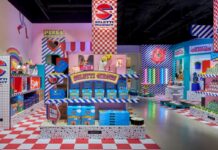The retail landscape has undergone significant transformations over the past few years. A decade ago, the rise of e-commerce threatened to overshadow physical stores, but bricks-and-mortar retail has defended itself well, experiencing a resurgence. Physical stores play a crucial role in offering people real-life experiences balancing the increasing move to online and keeping humanity in the purchasing process.
Luxury retailers have traditionally depended more on their physical stores than fast fashion brands. However, evolving consumer behaviours and expectations have prompted a reevaluation of the design of those stores. Previously, luxury brands such as Gucci, Chanel, Bottega Veneta and Burberry shared a uniform and understated aesthetic. Today, store designs are more distinctive and reflective of the creative directors’ visions. This shift towards a more individual and daring design language is aimed at differentiating brands in a crowded market.

The rise of online targeting and social media has raised expectations of shoppers which has a knock-on effect on stores. Consumers now look for both exceptional products and memorable retail experiences. In response, luxury brands have embraced various innovative design approaches, including pop-ups, artistic collaborations and full brand takeovers. These strategies boost the experiential element of retail, making the store formats work harder to create unique and immersive environments.
Increasingly, luxury brands are incorporating cultural and historical elements into their stores, localising global concepts so that the stores resonate better in the regions. For instance, Hermes has strategically placed four stores in New York, each in distinct cultural areas, including Brooklyn and Williamsburg. This approach helps luxury brands connect with new audiences and integrate into their cultural contexts. Apple has adopted this trend with its restoration of historic buildings such as old banks. By repurposing iconic structures, Apple has demonstrated a commitment to sustainability while recognising and investing in a community’s cultural heritage.
Pioneering brands are also aligning with the values of their socially responsible clientele. For example, Louis Vuitton and Prada have established private collections open to anyone, contributing to public culture. Chanel’s €25 million donation for the renovation of the Grand Palais in Paris underscores the brand’s dedication to cultural preservation and community engagement.
As brands look to offer unique experiences, they are increasingly combining the physical and digital elements to achieve this. For example, frequently collaborates with contemporary artists to create special store experiences as we saw with its recent partnership with Yayoi Kusama, which featured her iconic polka dot designs. This is an example of a luxury brand blending art with retail. Prada’s Epicenter stores, designed by architect Rem Koolhaas, push the boundaries of traditional retail spaces by integrating art, technology and innovative architectural elements. Gucci has transformed its stores into eclectic, museum-like spaces filled with vintage furniture, art pieces and customisable products, reflecting the brand’s bold and imaginative spirit. The Gucci Wooster Street store in New York is another example of this innovative approach. Burberry has pioneered a social retail concept in Shenzhen, China, which integrates physical and digital experiences; the store features interactive and personalised experiences through the WeChat platform.
Luxury retail is using its spaces to demonstrate its creativity and innovation, offering more and more engaging and experiential brand interactions for customers. Brands are using digital and physical touchpoints in new and exciting ways to connect with their consumers while maintaining the essence of luxury – exclusivity, bespoke offerings, and exceptional service.
















